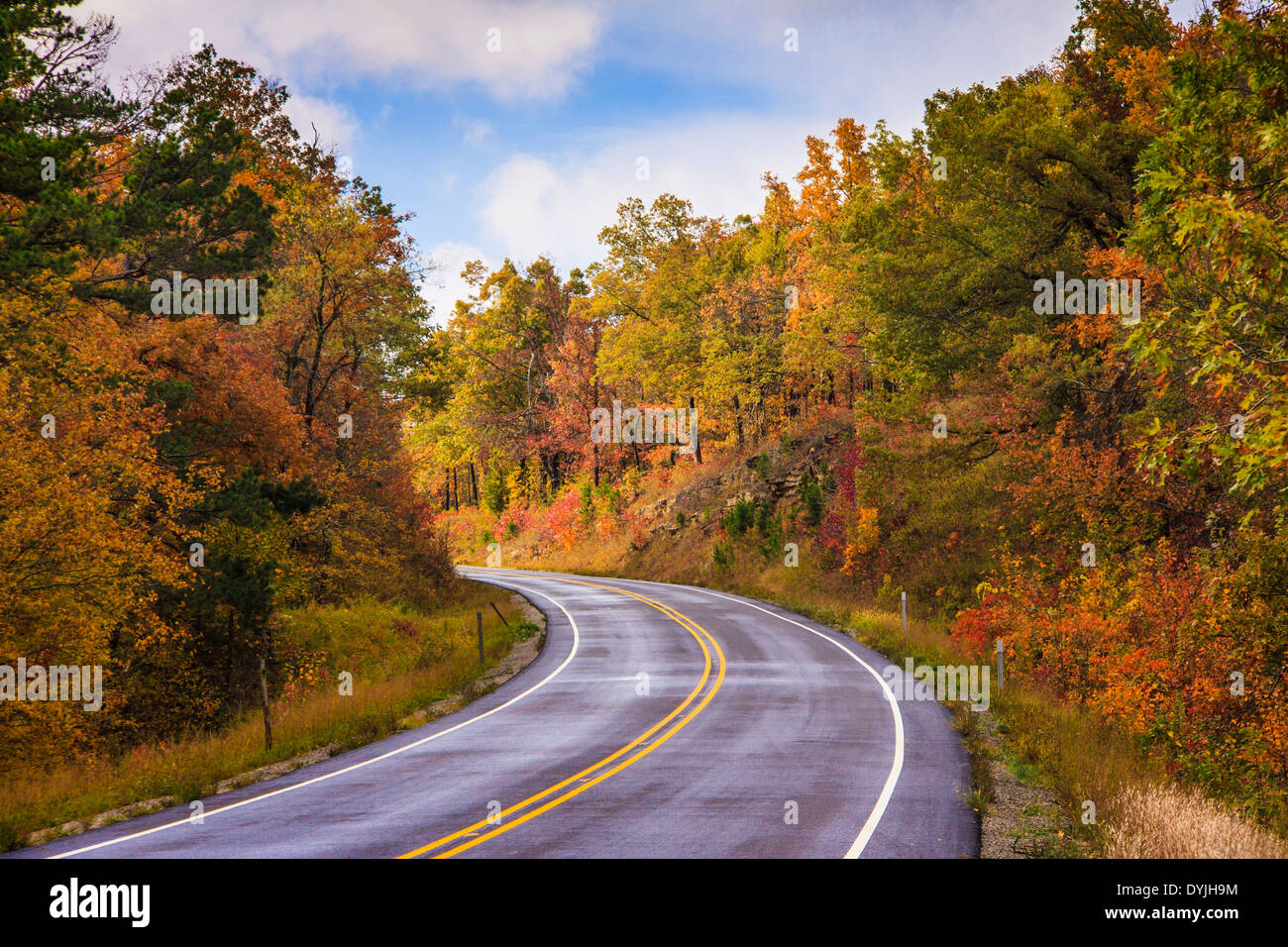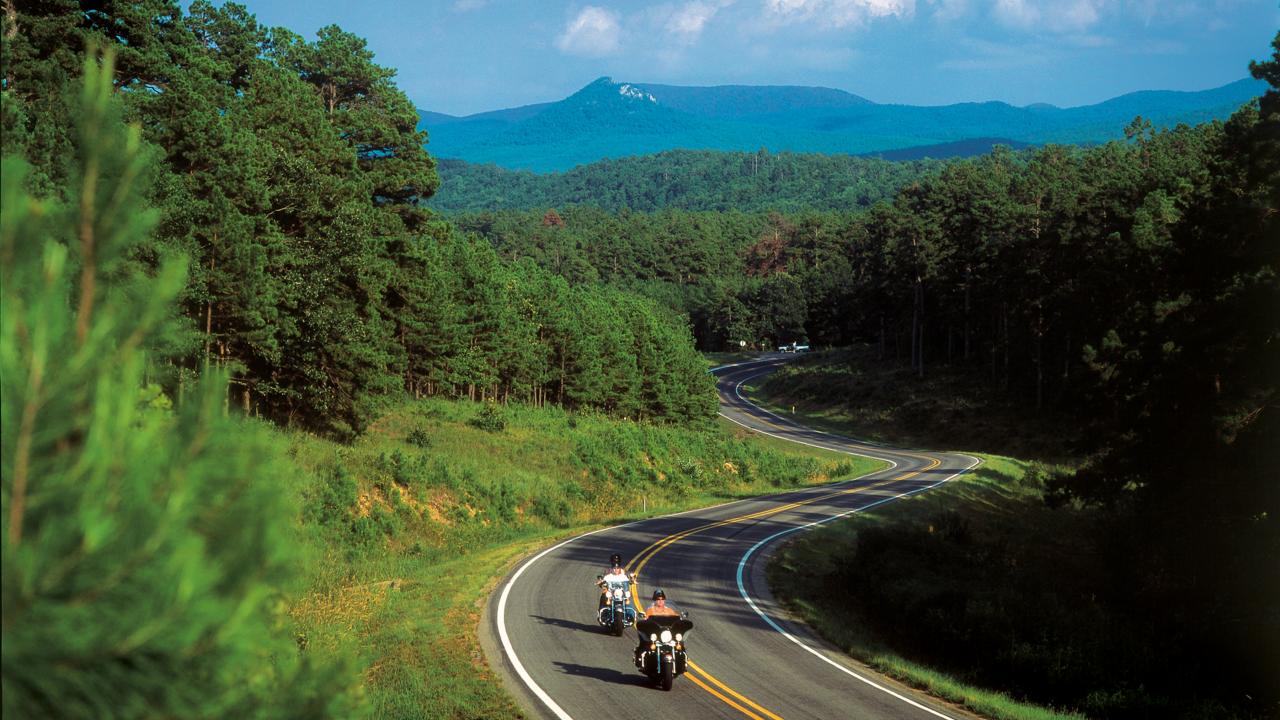
The Emerald Spine: A Journey Along Arkansas’s Scenic Highway 7
Arkansas, the "Natural State," is a tapestry woven with verdant forests, ancient mountains, and shimmering waterways. At its very heart, acting as a veritable emerald spine, runs Scenic Highway 7 – a route consistently lauded as one of America’s most beautiful drives. Stretching over 290 miles from the Missouri border in the north to the Louisiana line in the south, this ribbon of asphalt doesn’t just connect towns; it stitches together the diverse landscapes, rich history, and resilient spirit of Arkansas itself. It’s a journey that transcends mere transit, offering a profound immersion into the state’s natural grandeur and human heritage.
Designated as Arkansas’s first official scenic byway, Highway 7 is more than just a road; it’s an experience. It carves its way through two distinct mountain ranges – the rugged, ancient Ozarks in the north and the folded, forested Ouachitas in the south – showcasing a geological and ecological diversity that captivates every traveler. From the dramatic limestone bluffs and deep valleys of the Ozarks to the pine-clad ridges and pristine lakes of the Ouachitas, the byway offers a constantly evolving panorama, a symphony of natural beauty that shifts with every mile and every season.
The Northern Gateway: Ozark Majesty and Rustic Charms

The journey typically begins in the north, near the Missouri state line, where Highway 7 emerges from the rolling farmlands into the dramatic embrace of the Ozark Mountains. This region, characterized by its ancient, gnarled trees, limestone bluffs, and deep-cut valleys, feels like stepping back in time. The air here carries the scent of pine and damp earth, and the sounds of distant wildlife often punctuate the hum of the engine.
One of the first significant towns encountered is Harrison, a gateway to the region and often dubbed the "Crossroads of the Ozarks." From here, the road truly begins its serpentine dance, winding through the heart of the Ozark National Forest. This section is particularly beloved by motorcyclists and driving enthusiasts for its exhilarating curves, steep ascents, and sudden, breathtaking overlooks.
A highlight of the northern stretch is the proximity to the Buffalo National River, America’s first national river, protected for its free-flowing nature and stunning wilderness. While Highway 7 doesn’t directly parallel the Buffalo for long stretches, it provides access points and panoramic views of the surrounding watershed. Near the charming town of Jasper, often called the "Elk Capital of Arkansas," the byway offers some of its most iconic vistas. Here, the landscape unfurls into what is often referred to as the "Grand Canyon of the Ozarks," where deep valleys carved by Big Creek provide awe-inspiring panoramas, especially during the vibrant fall foliage season.
"There’s a raw, untamed beauty to the Ozarks that gets into your soul," says Sarah Jenkins, a photographer who frequently travels the byway. "Every bend reveals a new masterpiece – a hidden waterfall, a mist-shrouded valley, or the sheer scale of those ancient bluffs. It’s a landscape that demands your attention."
The towns along this northern segment, like Jasper and Dover, retain a rustic charm, reflecting the resilient spirit of the Ozark people. Local diners serve up hearty, traditional fare, and craft shops offer handmade goods, speaking to a heritage deeply rooted in self-sufficiency and a close connection to the land.
The Central Corridor: Rivers, Rocks, and Rural Transitions
As Highway 7 continues its southward trajectory, the Ozark landscape gradually begins to yield to the more open expanse of the Arkansas River Valley. This transition is subtle but significant, moving from the rugged, forested peaks to broader valleys dotted with agricultural fields and small, tight-knit communities.
The byway crosses the mighty Arkansas River near Russellville, a bustling town that serves as a hub for the region. Here, the road temporarily flattens, offering views of Lake Dardanelle, a large reservoir popular for fishing and boating. This central segment provides a moment of respite from the relentless curves, allowing travelers to appreciate the agricultural heartland of Arkansas before the next mountainous ascent.

A recommended detour, though not directly on Highway 7, is a visit to Petit Jean State Park, Arkansas’s first state park, located just east of the byway near Morrilton. This unique flat-topped mountain, crowned with ancient cedars, rises abruptly from the Arkansas River Valley, offering breathtaking views and a geological narrative dating back millions of years. Here, visitors can explore the iconic Cedar Falls, marvel at the Grotto, or ponder the mysterious rock formations of the "Turtle Rocks." The park also hosts the historic Mather Lodge and the Winthrop Rockefeller Institute, adding layers of natural and human history to the journey.
This central section of Highway 7, while perhaps less dramatically "scenic" in the immediate sense compared to the mountain passes, offers a crucial glimpse into the state’s economic and cultural diversity, showcasing the interplay between its natural resources and human endeavor. It’s a reminder that Arkansas is not just wilderness but also a vibrant, working landscape.
The Southern Ascent: Ouachita Wonders and Pristine Waters
Beyond the Arkansas River Valley, Highway 7 once again begins its climb, this time into the distinct and equally captivating Ouachita Mountains. Geologically, the Ouachitas are unique in the United States, being one of the few east-west trending mountain ranges. This creates a different character from the Ozarks – often steeper, more densely forested with pine and hardwoods, and punctuated by clear, deep lakes.
Entering the Ouachita National Forest, the byway transforms into a corridor of towering trees and serene solitude. The air here often feels cooler, carrying the scent of pine needles and damp earth. This section of Highway 7 is a haven for outdoor enthusiasts, offering countless opportunities for hiking, camping, fishing, and wildlife viewing. Deer, black bear, and a myriad of bird species call these forests home.
One of the crown jewels of this southern stretch is Lake Ouachita, often lauded as one of the cleanest lakes in the nation. Its crystal-clear waters, dotted with hundreds of small islands, invite visitors to swim, boat, and scuba dive. The sheer beauty of the lake, nestled among the forested peaks, is a testament to the region’s commitment to preserving its natural heritage. The byway offers numerous overlooks and access points to appreciate this aquatic marvel.
"Driving through the Ouachitas, you feel a sense of ancientness, a quiet power," notes Mark T. Johnson, a historian specializing in Arkansas’s natural resources. "The folded mountains tell a story of immense geological forces, and the pristine waters of Lake Ouachita are a direct result of the forest’s health. It’s a landscape that teaches you patience and perspective."
The Grand Finale: Hot Springs and Human History
The ultimate destination for many travelers on Scenic Highway 7 is the historic city of Hot Springs, a place where the wild beauty of the Ouachitas converges with centuries of human history and indulgence. As the byway descends into Hot Springs, the natural hot springs, which give the city its name, become the focal point.
Hot Springs National Park, remarkably, is located within the city limits, a unique distinction as "America’s First Resort." The centerpiece is Bathhouse Row, an architectural marvel featuring eight exquisitely preserved bathhouses from the Gilded Age, many of which are now museums or active spas where visitors can still "take the waters." These thermal springs, emerging at a constant 143 degrees Fahrenheit, have attracted people for thousands of years, from Native Americans seeking healing to European settlers, and later, notorious figures like Al Capone and baseball legends for spring training.
The juxtaposition of the rugged Ouachita wilderness just miles away from the ornate bathhouses and bustling downtown of Hot Springs is striking. It’s a powerful reminder of how humans have sought to harness and celebrate nature’s bounty. The city offers a vibrant mix of history, culture, art, and outdoor recreation, making it a fitting and fascinating culmination to the journey down Highway 7.
An Enduring Invitation
As Scenic Highway 7 continues its final stretch towards the Louisiana border, passing through more Ouachita forests and then gradually into the flatter coastal plains, it leaves an indelible impression. It’s a road that changes with the seasons – vibrant green in spring, lush in summer, ablaze with color in autumn, and starkly beautiful in winter. Each passage offers a new perspective, a fresh encounter with the soul of Arkansas.
Scenic Highway 7 is more than just a route; it’s a narrative, a living chronicle of Arkansas’s natural grandeur and human story. It invites drivers, motorcyclists, cyclists, and explorers to slow down, to breathe deeply, and to truly see the beauty that unfolds around them. From the rugged peaks of the Ozarks to the healing waters of Hot Springs, this emerald spine offers a journey of discovery, a testament to the enduring appeal of the open road, and a profound connection to the heart of the Natural State. For anyone seeking an authentic American road trip, a drive along Arkansas’s Scenic Highway 7 is an absolute imperative – an experience that lingers long after the engine is turned off.


